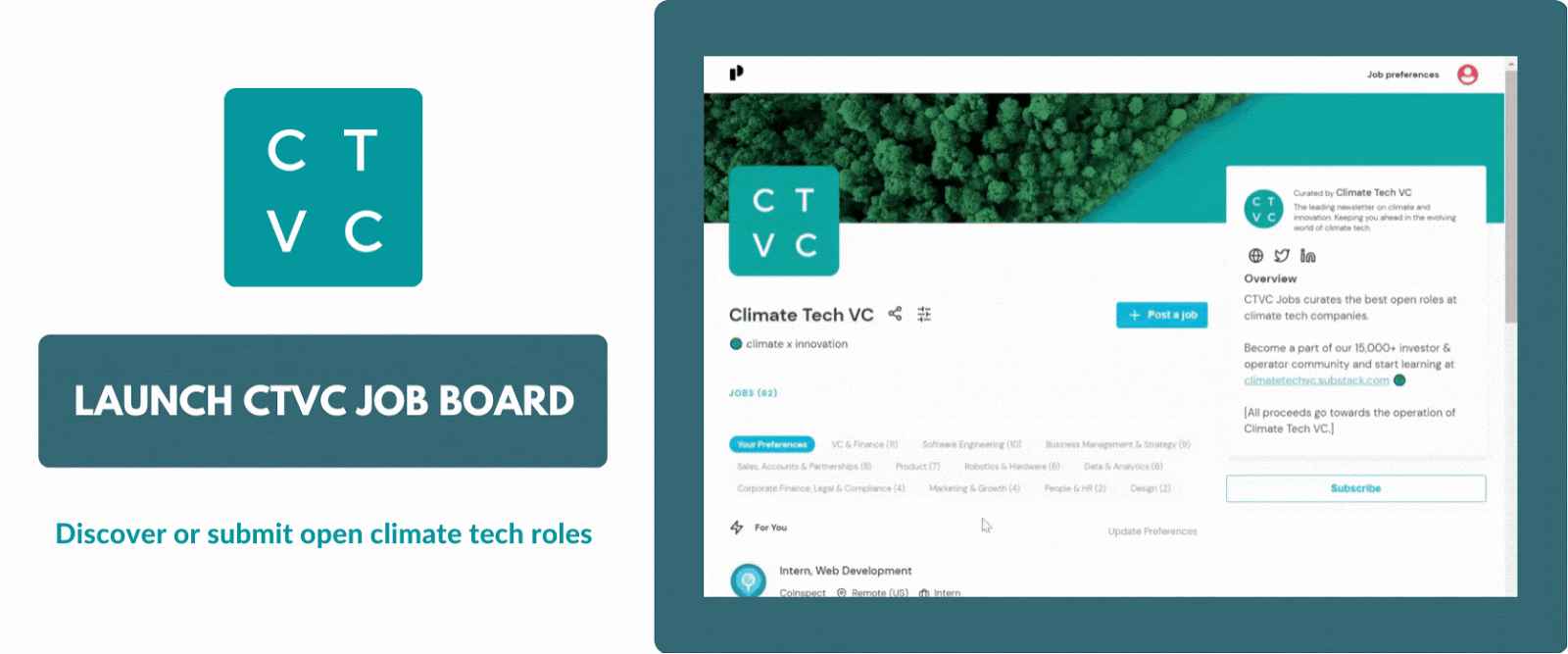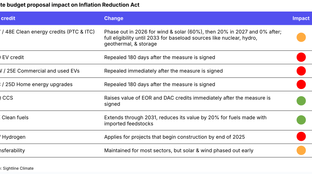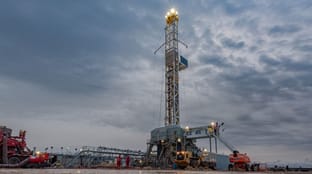
🌎 Overheard at LCAW #252
Climate, capital, and carrots in London's new playbook
CCS debate heats up and our job board to #workonclimate works!
Happy Monday!
Wow! Since we launched the CTVC Job Board on Friday, there’s been an outpouring of applications and enthusiasm from job seekers and climate tech companies alike.
jumped out of bed on Saturday morning to check the 24 hrs stats: 100+ job applications submitted, 1.5k clicks on jobs, 30 brand new jobs posted just today 🙌
— Sophie Purdom (@SophiePurdom) August 7, 2021
it's working! 🤩 https://t.co/OftXQsv8hW
Helping folks find a platform to #workonclimate has been one of the most personally rewarding parts of this newsletter. We’re thrilled to be able to help accelerate the work of the venture-stage climate tech community.
Meanwhile, we cover the latest CCS conversation, and channel divergent opinions around who should pay for carbon infrastructure and transportation. Tl;dr like any expensive and morally-fraught decision that requires government intercession, this story is just getting started.
Plus Quaise digs deep, SINAI announces their Seed, and Hydrosat and Hydrostor each pull in funding. We round out the issue with a bevy of earth science warnings from Mother Nature, as well as corporate partnerships and product releases galore.
Thanks for reading!
Not a subscriber yet?
Carbon Capture and Storage (CCS) is seeking a renewed lease on life. Events over the last few weeks – from high-profile endorsements to government actions – have raised awareness for CCS.
Several of these developments include:
✍️ Infrastructure Bill. For the first time, federal dollars have been earmarked for CCS. Section 10004 of the Infrastructure Bill (page 38) authorizes $3.5b for “Carbon Capture Large-Scale Pilot Projects and Carbon Capture Demonstration Project.”
📢 CCS Coalition. A group of more than 160 companies, labor unions, conservation and environmental groups, and other organizations sent a letter to House and Senate leaders to voice their support of bolstering CCS ventures through the infrastructure bills. Signed by a motley crew of allies from Shell to United Steelworkers to The Nature Conservancy, the letter includes specific requests to boost 45Q credits values and finance the buildout of regional CO2 transport.
🚨 CCS Blueprint. The Energy Futures Initiative (an organization run by former Obama-era Energy Secretary Ernest Moniz) and the AFL-CIO (a federation of 56 labor unions) published a policy blueprint of gigaton-scale CO2 transport and storage infrastructure. The “Building to Net-Zero” blueprint largely suggests policies the federal government can adopt to boost CO2 pipeline construction.
🤝 CCS with Secretary Granholm. Perhaps in a bid to boost CCS’ influence factor, Energy Secretary Jennifer Granholm released a video explaining and endorsing CCS last week.
Strong government support of CCS infrastructure, and CO2 transportation in particular, has opened a range of mixed feelings about CCS. Some argue that the 45Q tax credit is already strong enough and therefore denounce furthering government finance programs that subsidize private industry and perpetuate the status quo of the oil industry. Others argue government subsidization of CCS transportation is necessary to kickstart private sector investment, and has the benefit of creating green jobs. Another crowd reminds nitpickers that regardless of who is left holding the purse, CCS investment is cheap compared to the catastrophic effects of climate change from leaving excess CO2 in the atmosphere.
This begs the questions: Is CCS infrastructure and transportation a private or public good? Who should pay, and how much? Don’t have answers yet, but will surely be an interesting conversation.
✈️ Elroy Air, a San Francisco, CA-based hybrid-electric air cargo drone company, raised $40m in Series A funding from Marlinspike Capital, Prosperity7, Catapult Ventures, DiamondStream Partners, and others.
🏠 Plant Prefab, a Rialto, CA-based custom home builder using sustainable design, materials, and operations, raised $30m in Series B funding from Asahi Kasei Corporation, Paris Ventures, Amazon Alexa Fund, and the corporate VC program of Gerdau.
🌱 Planted, a Switzerland-based alternative protein company, raised $21m in “pre-B” funding from Vorwerk Ventures, Gullspång Re:food, Movendo Capital, Good Seed Ventures, Joyance, ACE & Company, and Be8 Ventures.
☄️ Quaise, a Cambridge, MA-based energy startup with a drilling technology that accesses deep geothermal energy, raised $12m in funding from Nabors Industries.
⚡ Hydrostor, a Canada-based long-duration energy storage solution provider, raised $10m in growth capital from the Business Development Bank of Canada.
💨 SINAI Technologies, a San Francisco, CA-based startup helping companies calculate internal carbon pricing, raised $10m in Seed funding from Obvious Ventures, Ajax Strategies, Valo Ventures, High Alpha, and others. [Disclaimer: Sophie is an investor]
💨 Carbon Clean, a UK-based carbon dioxide capture and separation technology startup, raised $8m in Series B funding from CEMEX, Equinor Ventures, ICOS Capital, and WAVE Equity Partners.
⚡ MGA Thermal, an Australia-based startup focused on thermal energy storage, raised $5.9m in funding from Main Sequence, Impact Capital, New Zealand’s Climate Venture Capital Fund, The Melt, CP Ventures, and angel investors.
⭐ Hydrosat, a Washington DC-based startup creating an infrared satellite constellation, raised $5m in Seed funding from Cultivation Capital, Freeflow Ventures, the Yield Lab, Expon Capital, Techstars, Industrious Ventures, and Synovia Capital.
Moody's is acquiring climate and natural disaster risk modeling company RMS for about $2b from Daily Mail and General Trust plc.
Surrounded by Detroit automakers and an array of electric vehicles, Biden signed an executive order calling for 50% of all new vehicles sold in the U.S. by 2030 to be electric - then he jumped in an electric Jeep and zoomed around the lawn.
Trump’s battle against climate science continues to bleed out the Biden administration’s progress, both in the capital and abroad. From the Agriculture Department to the Pentagon to the National Park Service, the national government suffers from a talent shortage of climate scientists and experts who either quit or were pushed out in the previous administration. Meanwhile six months into Biden’s presidency, John Kerry continues his international visits in an attempt to restore America’s reputation on climate and answer the question: “How do we know we can count on America?”
Over 21,500 firefighters are now on the ground tackling 80+ blazes in the western US. Meanwhile, wildfires rip (must click photos) through Eastern Europe and the Middle East. In a perverse positive feedback loop, kWh Analytics reports that wildfires hamper solar energy production and prediction.
A study found that only 5% of power plants in the world are responsible for 73% of global electric-sector emissions, proving the 80/20 rule more than true for pollutants.
GM has partnered with climate tech startups CTR and Lilac Solutions to source a “significant portion” of their battery materials through a closed-loop, direct lithium extraction process from geothermal brine in California's Salton sea.
Hot on the tail of Form Energy’s iron-air announcement, CATL launches sodium-ion batteries. Na-ion batteries have long enticed scientists for their lack of reliance on expensive rare metals, but have energy density limitations relating to capacity and cycling stability.
Batteries and hydrogen fuel cells dominate the truck electrification wars. But Germany is introducing a new contender: overhead cables, like the ones used to power trains.
Revel released 50 custom-painted blue ridesharing Teslas in Manhattan as the newest fleet in the company’s electric mobility mission. Revel’s drivers are unabashedly employees - not gig workers.
Redfin introduced a new feature that analyses climate risk based on a property’s location. The real estate brokerage firm partnered with ClimateCheck to provide extreme weather risk statistics to the contiguous US.
Exxon is considering a pledge to reduce its carbon emissions to zero by 2050 following pressure from investors, their lobbyist’s not so undercover comments last month, and Exxon CEO’s dismissal of other oil companies’ emissions-reduction commitments as a “beauty competition.”
Researches are warning with greater urgency that the critical “ocean conveyer belt” known as the AMOC which regulates global temperatures and weather systems shows warning signs of abruptly shutting off.
California’s second largest reservoir, Lake Oroville, now runs dry and won’t have enough water to generate power for the rest of the summer. The before and after pics say it all.
Not emeralds, green diamonds. TSCS-007, a new jewelry certification, sets sustainability standards with rigorous traceability and impact assessment for both mined and lab-grown diamonds.
Ramez Naam asked for book recs and the climate tech Twitter crowd went to town with some of our favorites: Hot, Flat, and Crowded, All We Can Save, Operating Manual for Spaceship Earth, and The Labyrinth of Technology.
The Predictive Analytics World (PAW) Climate conference has just released recordings and slides from all 20 sessions on AI and ML climate applications for free. Find it all here.
Governments control £7.8T of procurement spend that could accelerate climate technology deployment. The report from StateUp credits 50 startups greening government including CTVC alumni AMP Robotics and Circulor.
Liked our market map on earth observation? Check out Space Capital’s The Great Climate Opportunity report for more on the link between climate tech investing and persistent global monitoring and coordination.
Bloomberg profiles Plug Power as a case study in how to survive the changing investing climate. For more on Plug Power, see our interview with Jigar Shah.
What happens after the coal plants shut down? Their afterlives can be surprisingly wholesome.
The air is clearing on how clouds affect climate change, and the forecast is stormy. Several recent studies conclude that clouds will moderately amplify global warming.
🗓️ Diamond List: Join climate tech founders from Modern Synthesis (microbial weaving), unspun (robot-made jeans), and Vitro Labs (lab-grown leather) on August 13th for a discussion about sustainable fashion.
💡 Third Derivative: Apply by September 13th to enter the accelerator’s next cohort of climate tech startups addressing billion-dollar markets in the areas of hard science, hardware, software, and business model innovation.

We’ve moved our career content to our very own job board! Since we launched on Friday, you’ve posted nearly 100 roles, submitted 150 applications, and made 50 thousand impressions. If you’re interested in posting a job or finding your next new fit, visit our Pallet board or drop us an email 📩
Sustainability Production Coordinator @Netflix
Data Lead @BlocPower
Environmental Justice Analyst @Emerson Collective
Soil Scientist @Kula Bio
Feel free to send us new ideas, recent fundings, or general curiosities at 📩[email protected]. Have a great week ahead!

Climate, capital, and carrots in London's new playbook

US plays popcorn politics with biofuels and beyond

Groundbreaking results from the geothermal developer’s main project